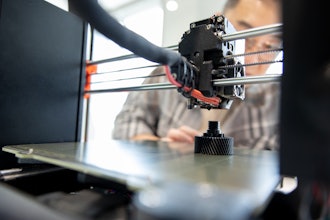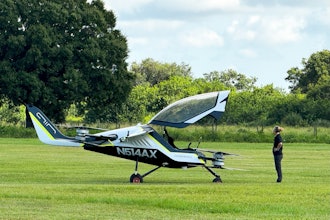
When GE opened its first research center in 1900, it employed three people and fit inside a barn behind the chief engineer’s house in Schenectady, N.Y.
It burned down a year later.
The lab then relocated to “safer premises” and become a dynamo, powering GE’s innovation, gathering thousands of patents and even employing several Nobel laureates. Today, the upstate New York lab is part of a global GE research network of some 3,000 scientists stretching from New York to Brazil, China, Germany, India, and China. Take a look at some of their projects that could one day shape the world.

Radislav Potyrailo, a principal scientist at GE Global Research, and his team are using the science of the very small, nanotechnology, and the science of light, photonics, to mimic the properties of the jagged, tree-like scales on the wings of butterflies from the Morpho genus (see top image). They want to use their findings to develop fast, ultra-sensitive thermal and chemical imaging sensors that could have applications in night vision goggles, super-sensitive surveillance cameras, and handheld and wearable medical diagnostic devices.

Potyrailo’s colleague Grigorii Soloveichik is working on electric flow batteries that could hold tens of kilowatt-hours of power. Besides cars, flow batteries could be used as backup power for wind farms and other renewable sources of energy, power entire neighborhoods, and also support the grid. “They can store energy from wind, for example, so power companies can use it when they need it,” Soloveichik says.
Engineer James Yang and his team are working on a technology called Direct Write, also known as 3D Inking. Big Data is the lifeblood of the Industrial Internet, and Direct Write allows machine designers to use special “inks” to print miniature data gathering sensors directly inside jet engines, gas turbines and other hot, harsh and hard to reach places. “We can use it to print sensors on 3D surfaces,” says Yang. “One day they could be anywhere.”

Not far from Schenectady, GE opened a new manufacturing and development facility exploring solid oxide fuel cell technology. Its fuel cells works like a battery, using a simple chemical reaction to unlock energy from hydrogen molecules abundant in natural gas and oxygen in ordinary air. The new system’s power generation efficiency can reach 65 percent, a holy grail of this technology. Its overall efficiency can grow even further: to 95 percent when the system is configured to capture waste heat produced by the process. “The cost challenges associated with the technology have stumped a lot of people for a long time,” says Johanna Wellington, advanced technology leader at GE Global Research and the head of GE’s fuel cell business. “But we made it work, and we made it work economically. It’s a game-changer.”

Sweat carries a trove of valuable information about how our bodies are feeling. Scientists at several labs are now trying to decode it with nanotechnology and develop flexible, Band-Aid-like wireless sensors sensitive enough to detect a single drop of biomolecules found in sweat in 2.5 million gallons of water (that’s enough to fill 50,000 bathtubs). The Air Force is interested in using the sensors to monitor pilots, and understand and improve their performance. But the technology could have much broader civilian applications. “Physical and mental fatigue is a factor for air traffic controllers, fire fighters, heavy-equipment operators, and many other professions,” says Scott Miller, lab manager for nanostructures and surfaces at GE Global Research.

Miller’s colleague Matt Webster is working on a universal calorie counter that could detect the amount of energy stored in any food. The GE team together with researchers at Baylor University’s Department Electrical and Computer Engineering is now testing the system on simple mixtures of oil, water and sugar. They have built a prototype, but the big prize is a push-button device that could be in every kitchen. One day the team could link the device with a smartphone app or a workout wristband.

GE is also working on machines that could study the brain in a greater detail. One group of researchers is looking at imaging the mobility of water molecules in the brain to better understand how the organ is wired, as well as the health and function of these connections, sort of a wiring diagram of the brain. In the future, medical scanners could be used to study diseases ranging from stroke to Alzheimer’s and clinical depression.

LED lights developed by engineers at GE Lighting could one day revolutionize agriculture and move farming indoors. One such farm is also working in Japan.

Scientists working in GE labs have developed tiny electrical switches thinner than a human hair that can transmit kilowatts of power. They are called micro-electro-mechanical systems, or MEMS. MEMS could help reduce waste heat and power consumption in medical devices, aviation systems and other industrial products. But the researchers are also working on miniaturized applications for smartphones and tablets using the next-generation LTE-Advanced, or “True 4G,” wireless standard. The new standard could allow users to receive data as fast as 3 gigabits per second, 10 times faster than existing 4G networks.
GE Ventures recently invested in Airware, a technology company developing a suite of hardware, software, and cloud services for commercial drone applications. Drones equipped with the technology already took part in an anti-poaching exercise in a northern white rhino wildlife preserve in Kenya. “We want to make it easy for customers to build drones for any commercial application and operate them in a safe and reliable manner,” says Jonathan Downey, founder and CEO of Airware. “This is something the industry as well as regulators have been asking for.”

GE researchers have used a special magnetic material to achieve temperatures cold enough to freeze water (and chill beer). The breakthrough system, which is projected to be 20 percent more efficient than current refrigeration technology, could be inside your fridge by the end of the decade.
The system is using a water-based fluid flowing through a series of magnets to transfer heat, rather than a chemical refrigerant and a compressor. This significantly lowers any harm to the environment and makes the recycling of old refrigerators simpler. “This is a big deal,” says Venkat Venkatakrishnan, a leader of the research team. “We are on the cusp of the next refrigeration revolution.”
For more articles like this, visit GE Reports.























